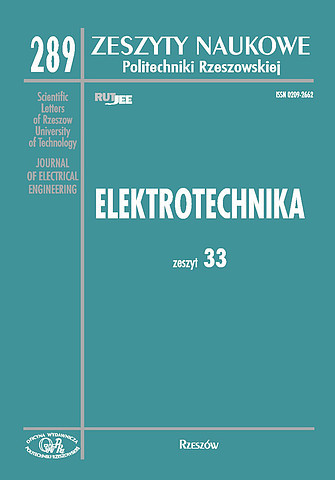Abstract
The paper presents algorithm of the hierarchical parasitic capacitance extraction of planar transmission lines. The algorithm utilizes direct Trefftz-Kupradze method which is derived from variational formulation. This approach lets one compare and contrast direct Trefftz-Kupradze method with popular Boundary Element and common formulation of both methods (the same boundary discretization, the same potential and flux interpolation, the same form of boundaryintegral equations). Considerations are reduced to 2D geometries and discretizations.are carried out by hierarchical binary decomposition. Boundary-integral equations for Laplace problem are formulated by appropriate method for each leaf-subdomain. Then, they are transformed into so-called Boundary Capacitance Matrices. In the process of tree traversal Boundary Capacitance Matrices are merged together. This matrix combining is done via Schur’s complement method. Finally, the last transformation of Boundary Capacitance Matrix yields General Capacitance Matrix of the system of conductors. Binary decomposition of the considered structures gives opportunity to build library of Boundary Capacitance Matrices for specific subdomain geometries and their utilization without the need of recalculation. By the means of proposed algorithm the influence of the distance of shifted collocation nodes (the feature specific for Trefftz-Kupradze method) is studied experimentally. The research yields quasi-optimal value of the distance, that is used in further numerical experiments. The obtained results are compared to analytical solutions and to the results given by Linpar application (method of moments). Keywords: parasitic capacitance, direct boundary methods, boundary element method, planar transmission lines.
References
[2] Bachtold, M., Korvink, J. G., and Baltes, H. Automatic adaptive meshing for efficient electrostatic boundary element simulations. In Simulation of Semiconductor Processes and Devices, 1996. SISPAD 96. 1996 International Conference on (1996), IEEE, 127-128.
[3] Bachtold, M., Spasojevic, M., Lage, C., and Ljung, P. B. A system for full-chip and critical net parasitic extraction for ULSI interconnects using a fast 3-D field solver. Computer-Aided Design of Integrated Circuits and Systems, IEEE Transactions on, 19, 3, 2000, 325-338.
[4] Benedek, P. and Silvester, P. Capacitance of Parallel Rectangular Plates Separated by a Dielectric Sheet. Microwave Theory and Techniques, IEEE Transactions on, 20, 8, 1972, 504-510.
[5] Borkowski, M. Ocena efektywności metod brzegowych w analizie parametrów resztkowych struktur planarnych. Rozprawa doktorska. Politechnika Rzeszowska, Rzeszów 2013.
[6] Brański A., Borkowski, M., and Borkowska, D. A comparison of boundary methods based on inverse variational formulation. Engineering Analysis with Boundary Elements, 36, 4, 2012, 505-510.
[7] Brebbia, C. A. and Dominguez, J. Boundary element methods for potential problems. Applied Mathematical Modelling, 1, 7, 1977, 372-378.
[8] Cheng, A. H. D. and Cheng, D. T. Heritage and early history of the boundary element method. Engineering Analysis with Boundary Elements, 29, 3, 2005, 268-302.
[9] Dengi, E. Aykut and Rohrer, Ronald A. Boundary element method macromodels for 2-D hierachical capacitance extraction. In Proceedings of the 35th annual Design Automation Conference (New York, NY, USA 1998), ACM, 218-223.
[10] Djordevic, Antonije, Djordjevic, Antonije R., and Sarkar, Tapan K. Linpar for Windows: Matrix Parameters for Multiconductor Transmission Lines, Twodiskettes and User's Manual (Microwave Software Library). Artech House Publishers.
[11] Fukuda, Sanae, Shigyo, Naoyuki, Kato, Kato, and Nakamura, Shin. A ULSI 2-D capacitance simulator for complex structures based on actual processes. IEEE Transactions on Computer-Aided Design of Integrated Circuits and Systems, 9, 1, 1990, 39-47.
[12] Gu, Jiangchun, Wang, Zeyi, and Hong, Xianlong. Hierarchical computation of 3D interconnect capacitance using direct boundary element method. In IEEE Asia South Pacific Design Automation Conference (2000), 447-452.
[13] Harrington, R. F., Pontoppidan, K., Abrahamsen, P., and Albertsen, N. C. Computation of Laplacian potentials by an equivalent-source method. Proceedings of the Institution of Electrical Engineers, 116, 10 (1969), 1715-1720.
[14] Heise, U. Numerical properties of integral equations in which the given boundary values and the sought solutions are defined on different curves. Computers & Structures, 8, 2, 1978, 199-205.
[15] Kao, W. H., Lo, Chi-Yuan, Basel, M., and Singh, R. Parasitic extraction: current state of the art and future trends. Proceedings of the IEEE, 89, 5, 2001, 729-739.
[16] Kita, E. and Kamiya, N. Trefftz method: an overview. Advances in Engineering Software, 24, 1-3 (1995), 3-12.
[17] Kupradze, V.D., Aleksidze, M. A. The method of functional equations for the approximate solution of certain boundary value problems (in Russian). USSR Computational Mathematics and Mathematical Physics, Vol. 4, No. 4. (1964), pp. 683-715.
[18] Li, Zi-Cai, Lu, Tzon-Tzer, Huang, Hung-Tsai, and Cheng, Alexander H. D. Trefftz, collocation, and other boundary methods -- A comparison. Numer. Methods Partial Differential Eq., 23, 1 (2007), 93-144.
[19] Patel, P. D. Calculation of Capacitance Coefficients for a System of Irregular Finite Conductors on a Dielectric Sheet. Microwave Theory and Techniques, IEEE Transactions on, 19, 11, (1971), 862-869.
[20] Patterson, C. and Sheikh, M. A. A regular boundary element method for fluid flow. International Journal for Numerical Methods in Fluids, 2, 3 (1982), 239-251.
[21] Paul, Clayton R. Analysis of Multiconductor Transmission Lines. Wiley-IEEE Press, 2007.
[22] Yu, Wenjian and Wang, Zeyi. An efficient quasi-multiple medium algorithm for the capacitance extraction of actual 3-D VLSI interconnects (2001), 366-371.
[23] Yu, W. and Wang, Z. Capacitance extraction. In Chang, Kai, ed., Encyclopedia of Rf and Microwave Engineering. 2005.





